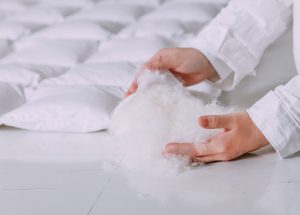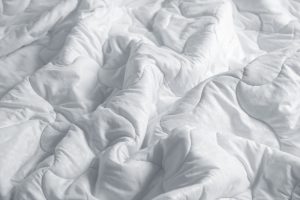Duvet Filling: How to Choose the Right One

When it comes to choosing the right filling for your duvet, you need to pay attention to their different characteristics and qualities.
Sometimes, and especially in relation to mattresses, duvets and everything we need to get a good night’s sleep, we often buy them without really knowing what we’re doing. If you want to avoid this, you need to know a little about the different types of fillings on the market so that you can choose the one that suits your needs.
Plus, because we can now buy from online stores, we have even more options to choose from. Generally, a really good quality duvet costs a minimum of $55.
When you’re wondering which filling to choose, you should ask yourself the following questions – your answers will determine which duvet you need.
- If you’re a warm or a cold person
- The time of year you’ll be using your duvet
- The average temperature in your bedrooms
- Whether your house is well insulated, and if you have good heating
Depending on the answers, which is to say, depending on how warm you want your duvet to be, you’ll find four main types of duvet, each one designed for a different time of year.
With these answers in mind, you’ll be able to narrow down your search, considerably reducing the number of options you have to choose from. As we all know, one of the advantages of having a duvet is that they help make making the bed simpler and quicker.
What makes a good duvet filling?
Next, before we take a look at the main types of duvet filling, we want to tell you some of the most important things that a good duvet needs to have.
- Thermal insulation: regardless of the time of year you’ll be using it, all duvet fillings should retain as much body heat as possible.
- Perspiration: how quickly or slowly moisture evaporates tells you a lot about the quality of the duvet.
- Cleaning and maintenance: in theory, both of these processes should be easy, as long as the filling is good quality.
- Lightness: although a duvet filling might look like it’s really thick, there’s no reason why it can still be really light. Even so, we still find some stores that classify fillings by the thicknesses available.
- Quilted: this is related to the type of filling.
- Anti-fungal, antibacterial and anti-mite protection: these are just some of the characteristics a duvet can have. They can also be hypoallergenic.
- Cover: we would recommend that you put your filling inside a cover before you put the exterior cover on. This will prevent the feathers from falling out. These covers are usually of cotton or microfibre.

Filling your duvet with feathers/down
Duvets fillings of feathers or down are known as natural duvets.
They are made from the feathers and down of birds such as ducks and geese. Don’t forget that the fillings will differ depending on the age and species of the bird. Both of these aspects will influence the type of feathers.
A good quilt should have more down than feathers, with roughly 90% down and 10% feathers. Why? Down can weigh ten times less than a single feather. Plus, the higher the quality of the down, the less you’ll need.
Remember that if you have a duvet filled with feathers, you’ll be able to feel the shafts of the feathers, which are known as rachis. If you have down on the other hand, you’ll hardly notice them, so you’ll have a softer, more fluffy duvet.

Synthetic fiber duvet fillings
Next, we’ll focus on the second type of duvet filling – synthetic filling.
These are generally lower quality than natural duvets, so they are usually less expensive, but they are also less durable. Just like with natural duvets, it’s important to know about the different types of fibers on the market.
They are usually made of cotton or hollow silicone fibers.
One example is bamboo fibers. Bamboo, which is being used more and more in our homes these days, is a sustainable material. Because this material is also 100% biodegradable, it is really environmentally friendly. Plus, bamboo is four times more breathable than cotton fibers. We often see this combined with silk.
Plus, some synthetic duvet fillings can even be stain resistant. Needless to say, this is a great advantage.

Conclusion
Finally, we just want to re-emphasize the importance of choosing the right duvet filling. Even though you might not give it much thought, it will actually help to improve the quality of your sleep. Once you’ve got the right filling, you then have to buy a cover that suits your tastes. This way, you’ll end up with the perfect combination of filling and cover – a duvet that is warm and, of course, looks great so that you have a comfortable and great quality bed.
When it comes to choosing the right filling for your duvet, you need to pay attention to their different characteristics and qualities.
Sometimes, and especially in relation to mattresses, duvets and everything we need to get a good night’s sleep, we often buy them without really knowing what we’re doing. If you want to avoid this, you need to know a little about the different types of fillings on the market so that you can choose the one that suits your needs.
Plus, because we can now buy from online stores, we have even more options to choose from. Generally, a really good quality duvet costs a minimum of $55.
When you’re wondering which filling to choose, you should ask yourself the following questions – your answers will determine which duvet you need.
- If you’re a warm or a cold person
- The time of year you’ll be using your duvet
- The average temperature in your bedrooms
- Whether your house is well insulated, and if you have good heating
Depending on the answers, which is to say, depending on how warm you want your duvet to be, you’ll find four main types of duvet, each one designed for a different time of year.
With these answers in mind, you’ll be able to narrow down your search, considerably reducing the number of options you have to choose from. As we all know, one of the advantages of having a duvet is that they help make making the bed simpler and quicker.
What makes a good duvet filling?
Next, before we take a look at the main types of duvet filling, we want to tell you some of the most important things that a good duvet needs to have.
- Thermal insulation: regardless of the time of year you’ll be using it, all duvet fillings should retain as much body heat as possible.
- Perspiration: how quickly or slowly moisture evaporates tells you a lot about the quality of the duvet.
- Cleaning and maintenance: in theory, both of these processes should be easy, as long as the filling is good quality.
- Lightness: although a duvet filling might look like it’s really thick, there’s no reason why it can still be really light. Even so, we still find some stores that classify fillings by the thicknesses available.
- Quilted: this is related to the type of filling.
- Anti-fungal, antibacterial and anti-mite protection: these are just some of the characteristics a duvet can have. They can also be hypoallergenic.
- Cover: we would recommend that you put your filling inside a cover before you put the exterior cover on. This will prevent the feathers from falling out. These covers are usually of cotton or microfibre.

Filling your duvet with feathers/down
Duvets fillings of feathers or down are known as natural duvets.
They are made from the feathers and down of birds such as ducks and geese. Don’t forget that the fillings will differ depending on the age and species of the bird. Both of these aspects will influence the type of feathers.
A good quilt should have more down than feathers, with roughly 90% down and 10% feathers. Why? Down can weigh ten times less than a single feather. Plus, the higher the quality of the down, the less you’ll need.
Remember that if you have a duvet filled with feathers, you’ll be able to feel the shafts of the feathers, which are known as rachis. If you have down on the other hand, you’ll hardly notice them, so you’ll have a softer, more fluffy duvet.

Synthetic fiber duvet fillings
Next, we’ll focus on the second type of duvet filling – synthetic filling.
These are generally lower quality than natural duvets, so they are usually less expensive, but they are also less durable. Just like with natural duvets, it’s important to know about the different types of fibers on the market.
They are usually made of cotton or hollow silicone fibers.
One example is bamboo fibers. Bamboo, which is being used more and more in our homes these days, is a sustainable material. Because this material is also 100% biodegradable, it is really environmentally friendly. Plus, bamboo is four times more breathable than cotton fibers. We often see this combined with silk.
Plus, some synthetic duvet fillings can even be stain resistant. Needless to say, this is a great advantage.

Conclusion
Finally, we just want to re-emphasize the importance of choosing the right duvet filling. Even though you might not give it much thought, it will actually help to improve the quality of your sleep. Once you’ve got the right filling, you then have to buy a cover that suits your tastes. This way, you’ll end up with the perfect combination of filling and cover – a duvet that is warm and, of course, looks great so that you have a comfortable and great quality bed.







